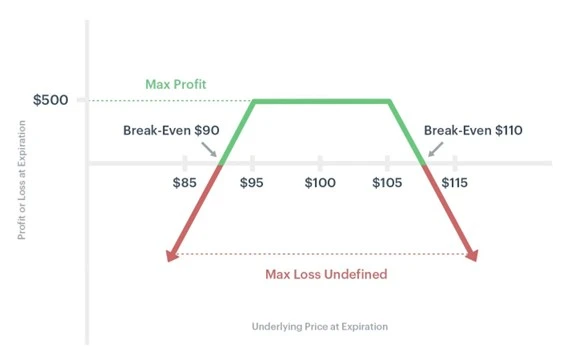Investors are always exploring opportunities to maximize their profits while simultaneously looking for ways to minimize their risks. One strategy that has gained popularity in recent years is the short strangle option.
This powerful trading technique allows investors to profit from sideways-moving markets while limiting their potential losses. However, like any investment strategy, risks are involved, and it is crucial to understand how the strategy works before attempting to use it.
Whether you are a seasoned options player or a novice looking to expand your investment portfolio, this article will provide you with the tools and knowledge you need to succeed with the short strangle option.
We go into the ins and outs of this complex trade strategy, including its benefits, risks, and the importance of implementing this strategy. By the end of reading this, we hope your understanding of this dual-option spread would stand solidified.
What Is Short Strangle?
A short strangle or shorting strangle is an options trading strategy where a trader simultaneously sells a call and put option on a single underlying asset with the same expiration date, at strike prices above and below the current market price.
The goal of short strangles is to generate income from the premiums received from selling both options and to profit if the price of the underlying asset stays within a certain range until the options expire. This simultaneous selling creates a profit zone in a neutral market.
The potential profit from short strangles is limited to the premiums collected, but the risk is unlimited if the price of the underlying asset moves significantly beyond the strike price of either option.
Traders often use this strategy in a neutral or slightly volatile market, where they believe the underlying asset is unlikely to experience large price movements. It thus allows the potential of a gain to arise in a highly narrow profit zone, as displayed in the image below:

What Are The Short Strangle Options?
When turning to short strangle options, traders can customize their strategies precisely in line with their risk profile and investment preferences. The following are some options they may employ under this approach:
-
Strike Price Adjustment
The trader can adjust the strike prices of the call and put options to create a wider or narrower range of profitability. A wider range would reduce the potential profit but also reduce the risk.
-
Expiry Date Adjustment
The option’s expiry date too can be adjusted to create a longer or shorter holding period. A longer holding period could increase the potential profit, but it also increases the risk of adverse price movements.
-
Hybrid Trading Approach
Instead of selling both calls and puts, the trader can use different options types, such as selling a straddle (selling both a call and put option with the same strike price) or a ratio spread (selling more options on one side of the trade than the other).
-
Incorporating Directional Bias
By selling a call or put option at a higher or lower strike price, a trader could essentially be adding directional bias by selling the call or put at a higher or lower price. This allows greater flexibility for short strangle options.
What Is Short Strangle Options Strategy?
We now turn our attention to the underlying strategy that short strangles essentially cater to. Understanding this strategic underpinning of the approach could help shed light on its use.
The short strangle options strategy is primarily a neutral one that can cater to traders who have a neutral market outlook and expect the underlying asset to remain range-bound or experience low volatility.
The short strangle options strategy can be a useful strategy for traders who have a neutral outlook on the underlying asset, as it allows them to profit from a range-bound market with limited downside risk.
It must be noted that the downside risk is only limited to the extent that the market actually is neutral, and the trader is certain of this. In the case where the underlying spot price takes a plunge, the losses could be limitless on the sell side.
What Is Selling Strangle?
A selling strangle is another name for the strangle, and is called such because the trading maneuver involves selling an out-of-the-money call option and an out-of-the-money put option simultaneously.
The term “short” refers to the fact that the trader is selling (shorting) the call and put options to open the position. By selling both a call and a put option, the trader is essentially betting that the underlying asset will remain within a certain price range until the options expire.
If the price stays within that range, both the call and put options will expire worthless, and the trader will keep the premiums they received for selling them.
However, if the price of the underlying asset moves significantly in either direction beyond the strike prices of the options, the trader can suffer significant losses. Like any sell-side strategy, the loss could be limitless, which spells the need for caution and market research.
Why Is Short Strangle Important For Investors?
As an innovative way to make gains, even when the market is relatively static, the short strangle is incredibly important for investors seeking profits in every conceivable circumstance the market is facing.
This strategy can be particularly attractive in a market that is expected to be range-bound, as it allows the investor to profit from the lack of significant price movements.
Unlike other trading strategies, particularly those that involve shorts, the selling strangle finds opportunity in neutral markets as opposed to volatile ones. Due to this, it offers strong diversity benefits, allowing investors to benefit when the market enters a static state.
When used in conjunction with other investment strategies, the shorting strangle strategy can further enhance one’s investment portfolio. Some strong combinations could potentially include long positions in stocks or ETFs, to further diversify the portfolio.
How Volatility Impacts Short Strangles?
As pointed out above, the key environment when short strangles are deployed is during neutral markets, or static states when both upward and downward movement is generally limited.
As one would expect, volatility shifts are quite consequential for short strangles. With higher volatility, the premiums for calls and puts are also higher, which can make the strangle strategy more attractive to investors looking to generate income from their portfolios.
Although the higher premiums provide more potential income for the investor, the risk potential is far higher. This is especially important to consider given the limitless downside risk on short positions.
Investors may need to adjust their short positions based on changes in volatility. If volatility rises, the investor may need to widen the strike price range of the options they sold to reduce the risk of the underlying asset’s price moving beyond the options’ strike prices.
How Theta Impacts Short Strangles?
When discussing short strangles, it is impossible to do so without delving into the implications of the theta phenomenon. Theta essentially signifies time decay and is the rate at which an option’s value decreases over time as it approaches its expiration date.
Whenever embarking upon short strangles, traders always take theta into consideration, due to the impact it has on the strategy. Some of these are described below:
-
Time-Frame
Short strangles rely on the options expiring worthless, so the trader needs to choose an expiration date that allows enough time for the options to expire but not so much time that the rate of time decay reduces the premiums received for selling the options.
-
Profitability
As the options approach their expiration date, the rate of time decay accelerates, causing the option’s value to decrease at a faster rate.
This means that the premiums for the options sold may decrease over time, potentially reducing the investor’s potential profit.
-
Adjustment
Theta impacts adjustments on short strangles because the trader would need to timely shift positions if the rate of decay on the value is too high. This would be undertaken to ensure the underlying spot price remains within the profitable zone.
Conclusion
Short strangles are a popular form of trading in the derivatives markets which aim to profit by collecting the premiums from both call and put options while betting that the underlying asset’s price will remain within a narrow range until the expiry of the option.
In this article, we have explored the intricacies of the strangle strategy, including its importance and strengths. We have examined the various factors that can affect the profitability of this strategy, such as implied volatility and the theta.
Overall, a short strangle can be a powerful tool for experienced traders who are willing to take on significant risks in exchange for the potential for high returns. Its ability to deliver income despite a neutral or static market makes it especially remarkable.
FAQs
How Profitable Is Short Strangle?
Short strangles can be quite profitable as long as they are executed flawlessly. Profitability would also depend on several factors, such as the underlying asset’s price movement, implied volatility, and time decay.
How Do You Run A Short Strangle Strategy?
To run a short strangle strategy, a trader needs to sell a call and a put option with different strike prices and the same expiration date, while expecting the underlying asset’s price to stay within a certain range until the options expire
What Is The Best Adjustment for A Short Strangle?
The best adjustment for a short strangle is to roll the untested side of the position further away from the current price, while also considering reducing the position size or closing the trade if necessary to manage risk.










